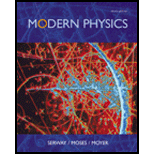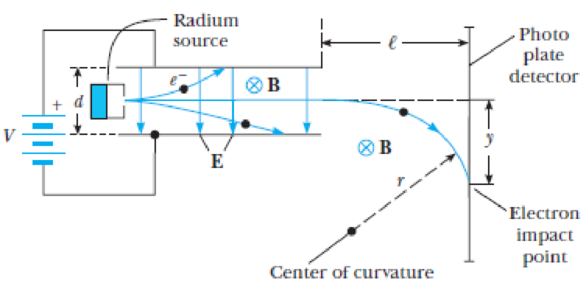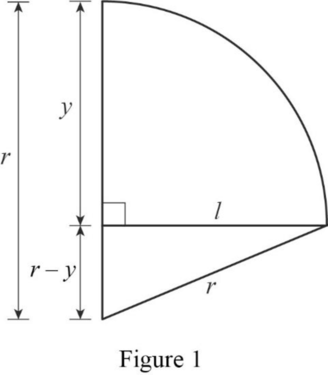
A Thomson-type experiment with relativistic electrons. One of the earliest experiments to show that p = γmv (rather than p = mv) was that of Neumann. [G. Neumann, Ann. Physik 45:529 (1914)]. The apparatus shown in Figure P4.5 is identical to Thomson’s except that the source of high-speed electrons is a radioactive radium source and the magnetic field B is arranged to act on the electron over its entire trajectory from source to detector. The combined electric and magnetic fields act as a velocity selector, only passing electrons with speed v, where v = V/Bd (Equation 4.6), while in the region where there is only a magnetic field the electron moves in a circle of radius r, with r given by p = Bre. This latter region (E = 0, B = constant) acts as a momentum selector because electrons with larger momenta have paths with larger radii. (a) Show that the radius of the circle described by the electron is given by r = (l2 + y2)/2y. (b) Typical values for the Neumann experiment were d = 2.51 × 10−4 m, B = 0.0177 T, and l = 0.0247 m. For V = 1060 V, y, the most critical value, was measured to be 0.0024 ± 0.0005 m. Show that these values disagree with the y value calculated from p = mv but agree with the y value calculated from p = γmv within experimental error. (Hint: Find v from Equation 4.6, use mv = Bre or γmv = Bre to find r, and use r to find y.)

Figure P4.5 The Neumann apparatus.
(a)
To show that the radius of the circle described by th electron is given by
Answer to Problem 5P
It is showed that the radius of the circle described by th electron is given by
Explanation of Solution
The curved path of the electron is shown in figure 1.

Write the equation for the curved path of the electron.
Here,
Rewrite the above equation.
Rewrite the above equation for
Conclusion:
Therefore, it is showed that the radius of the circle described by th electron is given by
(b)
To show that the value of
Answer to Problem 5P
It is showed that the calculated that the value of
Explanation of Solution
Write the equation for the velocity of the electron.
Here,
Write the equation for the momentum of the electron.
Here,
Write the classical expression for the momentum of a particle.
Here,
Equate equations (III) and (IV) and rewrite it for
Write the relativistic equation for the momentum of the particle.
Here,
Equate equations (III) and (VI) and rewrite it for
Write the equation for the Lorentz factor.
Here,
Put the above equation in equation (VII).
Write the equation for the root of a quadratic equation
Conclusion:
The mass of the electron is
Substitute
Substitute
Substitute
Comparison of the above equation with the quadratic equation
Substitute
The value
The value
Substitute
Substitute
Comparison of the above equation with the quadratic equation
Substitute
The value
The value
Therefore, it is showed that the calculated that the value of
Want to see more full solutions like this?
Chapter 4 Solutions
Modern Physics
- What are the expected readings of the ammeter and voltmeter for the circuit in the figure below? (R = 5.60 Ω, ΔV = 6.30 V) ammeter I =arrow_forwardsimple diagram to illustrate the setup for each law- coulombs law and biot savart lawarrow_forwardA circular coil with 100 turns and a radius of 0.05 m is placed in a magnetic field that changes at auniform rate from 0.2 T to 0.8 T in 0.1 seconds. The plane of the coil is perpendicular to the field.• Calculate the induced electric field in the coil.• Calculate the current density in the coil given its conductivity σ.arrow_forward
- An L-C circuit has an inductance of 0.410 H and a capacitance of 0.250 nF . During the current oscillations, the maximum current in the inductor is 1.80 A . What is the maximum energy Emax stored in the capacitor at any time during the current oscillations? How many times per second does the capacitor contain the amount of energy found in part A? Please show all steps.arrow_forwardA long, straight wire carries a current of 10 A along what we’ll define to the be x-axis. A square loopin the x-y plane with side length 0.1 m is placed near the wire such that its closest side is parallel tothe wire and 0.05 m away.• Calculate the magnetic flux through the loop using Ampere’s law.arrow_forwardDescribe the motion of a charged particle entering a uniform magnetic field at an angle to the fieldlines. Include a diagram showing the velocity vector, magnetic field lines, and the path of the particle.arrow_forward
- Discuss the differences between the Biot-Savart law and Coulomb’s law in terms of their applicationsand the physical quantities they describe.arrow_forwardExplain why Ampere’s law can be used to find the magnetic field inside a solenoid but not outside.arrow_forward3. An Atwood machine consists of two masses, mA and m B, which are connected by an inelastic cord of negligible mass that passes over a pulley. If the pulley has radius RO and moment of inertia I about its axle, determine the acceleration of the masses mA and m B, and compare to the situation where the moment of inertia of the pulley is ignored. Ignore friction at the axle O. Use angular momentum and torque in this solutionarrow_forward
- A 0.850-m-long metal bar is pulled to the right at a steady 5.0 m/s perpendicular to a uniform, 0.650-T magnetic field. The bar rides on parallel metal rails connected through a 25-Ω, resistor (Figure 1), so the apparatus makes a complete circuit. Ignore the resistance of the bar and the rails. Please explain how to find the direction of the induced current.arrow_forwardFor each of the actions depicted, determine the direction (right, left, or zero) of the current induced to flow through the resistor in the circuit containing the secondary coil. The coils are wrapped around a plastic core. Immediately after the switch is closed, as shown in the figure, (Figure 1) in which direction does the current flow through the resistor? If the switch is then opened, as shown in the figure, in which direction does the current flow through the resistor? I have the answers to the question, but would like to understand the logic behind the answers. Please show steps.arrow_forwardWhen violet light of wavelength 415 nm falls on a single slit, it creates a central diffraction peak that is 8.60 cm wide on a screen that is 2.80 m away. Part A How wide is the slit? ΟΙ ΑΣΦ ? D= 2.7.10-8 Submit Previous Answers Request Answer × Incorrect; Try Again; 8 attempts remaining marrow_forward
 Modern PhysicsPhysicsISBN:9781111794378Author:Raymond A. Serway, Clement J. Moses, Curt A. MoyerPublisher:Cengage Learning
Modern PhysicsPhysicsISBN:9781111794378Author:Raymond A. Serway, Clement J. Moses, Curt A. MoyerPublisher:Cengage Learning University Physics Volume 3PhysicsISBN:9781938168185Author:William Moebs, Jeff SannyPublisher:OpenStax
University Physics Volume 3PhysicsISBN:9781938168185Author:William Moebs, Jeff SannyPublisher:OpenStax College PhysicsPhysicsISBN:9781938168000Author:Paul Peter Urone, Roger HinrichsPublisher:OpenStax College
College PhysicsPhysicsISBN:9781938168000Author:Paul Peter Urone, Roger HinrichsPublisher:OpenStax College Glencoe Physics: Principles and Problems, Student...PhysicsISBN:9780078807213Author:Paul W. ZitzewitzPublisher:Glencoe/McGraw-Hill
Glencoe Physics: Principles and Problems, Student...PhysicsISBN:9780078807213Author:Paul W. ZitzewitzPublisher:Glencoe/McGraw-Hill Principles of Physics: A Calculus-Based TextPhysicsISBN:9781133104261Author:Raymond A. Serway, John W. JewettPublisher:Cengage Learning
Principles of Physics: A Calculus-Based TextPhysicsISBN:9781133104261Author:Raymond A. Serway, John W. JewettPublisher:Cengage Learning





